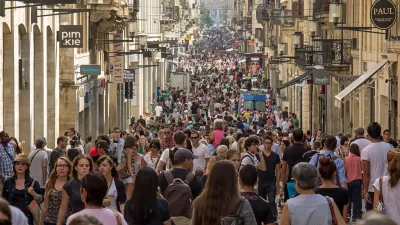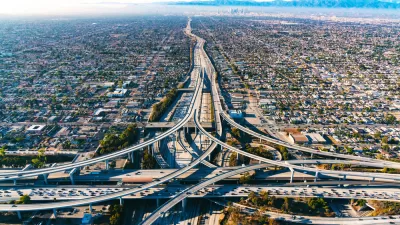Sprawl leads to more emissions, but the economic costs are also high. Policies and strategies that ensure compact growth are essential.

Catlyne Haddaoui considers the implications of an August 2018 report from The New Climate Economy that says more sustainable, compact urban development will lead to global economic savings of up to $17 trillion by 2050. “Compact cities produce fewer emissions because they tend to offer better access to public transit and cycling and walking paths, have greater energy efficiency, have lower environmental costs for infrastructure, and allow for more green spaces.”
She reports that infrastructure is less costly to build and maintain in compact cities, and residents in these cities do not have to travel as far or deal with congestion and air pollution, which then boosts GDP. In addition, says Haddaoui, compact cities bring people together, spur innovation, and increase productivity.
Strategies for compact growth need to stop sprawl, which promotes auto dependence, single-family homes, and low-density development. Haddaoui says shifting people from driving to sustainable modes of travel is crucial, and this change will happen through transportation infrastructure investments.
She adds that these investments need to be coupled with national policies that further support compact development. “Governments will need to reform spatial plans, building codes and tax incentives to discourage sprawl. And they’ll need to do this while avoiding the displacement of low-income or other marginalized urban residents as inner-city areas become more attractive,” says Haddaoui.
FULL STORY: Cities Can Save $17 Trillion by Preventing Urban Sprawl

Alabama: Trump Terminates Settlements for Black Communities Harmed By Raw Sewage
Trump deemed the landmark civil rights agreement “illegal DEI and environmental justice policy.”

Planetizen Federal Action Tracker
A weekly monitor of how Trump’s orders and actions are impacting planners and planning in America.

The 120 Year Old Tiny Home Villages That Sheltered San Francisco’s Earthquake Refugees
More than a century ago, San Francisco mobilized to house thousands of residents displaced by the 1906 earthquake. Could their strategy offer a model for the present?

In Both Crashes and Crime, Public Transportation is Far Safer than Driving
Contrary to popular assumptions, public transportation has far lower crash and crime rates than automobile travel. For safer communities, improve and encourage transit travel.

Report: Zoning Reforms Should Complement Nashville’s Ambitious Transit Plan
Without reform, restrictive zoning codes will limit the impact of the city’s planned transit expansion and could exclude some of the residents who depend on transit the most.

Judge Orders Release of Frozen IRA, IIJA Funding
The decision is a victory for environmental groups who charged that freezing funds for critical infrastructure and disaster response programs caused “real and irreparable harm” to communities.
Urban Design for Planners 1: Software Tools
This six-course series explores essential urban design concepts using open source software and equips planners with the tools they need to participate fully in the urban design process.
Planning for Universal Design
Learn the tools for implementing Universal Design in planning regulations.
Clanton & Associates, Inc.
Jessamine County Fiscal Court
Institute for Housing and Urban Development Studies (IHS)
City of Grandview
Harvard GSD Executive Education
Toledo-Lucas County Plan Commissions
Salt Lake City
NYU Wagner Graduate School of Public Service





























